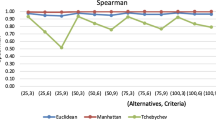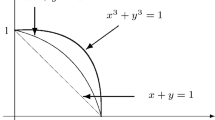Abstract
The aim of this paper is to summarize the historical development of the concept of a fuzzy preference structure and to present the resulting material in a logical manner. Roughly speaking, three phases can be distinguished. In the first phase, different proposais for constructing fuzzy strict preference and indifference relations emerge. In the second one, this construction is approached in an axiomatic way, by imposing couditions on the fuzzy strict preference, indifference and incomparability relations, leading to functional equations identifying suitabie strict preference, indifference and incomparability generators. Surprisingly, the detinition of a fuzzy preference structure was only given in the third phase, leading to the study of additive fuzzy preference structures. Combined with results from the axiomatic approach, this has linally led to the discovery of characterizable fuzzy preference structures.
Riassunto
Scopo di questo lavoro è quello di riassumere lo sviluppo storico del concetto di struttura di preferenza fuzzy e presentare i risultati in modo logico.
Si possono approssimativamente distinguere tre fasi. Nella prima emergono diverse proposte per costruite relazioni fuzzy di preferenza stretta ed indifferenza.
Nella seconda fase questa costruzione viene affrontata in modo assiomatico imponendo condizioni che conducono alle equazioni funzionali che identificano i generatori di preferenza stretta, indifferenza e non confrontabilità.
E sorpredente che la definizione di struttura di preferenza fuzzy sia stata solo la terza fase, che conduce allo studio delle preferenze fuzzy additive.
Combinata con i risultati derivanti dall»pproccio assiomatico, questa fase ha fiualmente condotto alla caratterizzazione della struttura di preferenza fuzzy.
Similar content being viewed by others
References
Alsina C,On a family of connectives for fuzzy sets, Fuzzy Sets and Systems, 16, 1985, 231–235.
Bilciç T.,Interval-valued preference structures, European Journal of Operational Research, 105, 1998, 162–183.
Billot A.,Economic Theory of Fuzzy Equilibria, Springer. Berlin, 1995.
Block H., Marschack J.,Random orderings and stochastic theories of responses, Contributions to Probability and Statistics, I. Olkin, S. Ghurye, W. Hoefding, W. Madow and H. Mann, Stanford University Press, Stanford, California, 1959.
Bouyssou D.,Ranking methods based on valued preference relations: a characterization of the net flow method. European Journal of Operational Research, 61, 1992, 186–194.
De Baets B., Kerre E.,Fuzzy relations and applications, Advances in Electronics and Electron Physics, P. Hawkes, Academic Press, 89, 1994, 255–324.
De Baets B., Van de Walle B.,Weak and strong fuzzy interval orders, Fuzzy Sets and Systems, 79, 1996. 213–225.
De Baets B., Van De Walle B.,Fuzzy preference modelling based on continuous de Morgan triplets, Proceedings of the First International Workshop on Preferences and Decisions (Treuto, Italy), 1997, 15–20.
De Baets B., Van de Walle B.,Minimal definitions of classical and fuzzy preference structures, Proceedings of the Annual Meeting of the North American Fuzzy Information Processing Society (Syracuse, New York, USA), 1997, 299–304.
De Baets B., Van de Walle B., Kerre E.,Fuzzy preference structures and their characterization, Journal of Fuzzy Mathematics, 3, 1995, 373–381.
De Baets B., Van de Walle B., Kerre E.,Fuzzy preference structures without incomparability, Fuzzy Sets and Systems, 76, 1995, 333–348.
De Baets B., Van de Walle B., Kerre E.,The Frank t-norm family in fuzzy preference modelling, Proceedings of the Fourth European Congress on Intelligent Techniques and Soft Computing (Aachen, Germany), H.-J. Zimmermann, 1, ELITE, Aachen, 1996, 78–82.
De Baets B., Van de Walle B., Kerre E.,A two-parameter class of fuzzy preference structures, Proceedings of the International Conference on Methods and Applications of Multicriteria Decision Making (Mons, Belgium), 1997, 196–199.
De Baets B., Van De Walle B., Kerre E.,A plea for the use of Lukasiewicz triplets in fuzzy preference structures, Part 2: The identity case, Fuzzy Sets and Systems, (to appear).
Doignon J.-P., Monjardet B., Roubens M., Vincke PH.,Biorder families, valued relations and preference modelling, Journal of Mathematical Psychology, 30, 1986, 435–480.
Fodor, J. C., Strict preference relations based on weak t-norms, Fuzzy Sets and Systems, 43, 1991, 327–336.
Fodor J. C.,An axiomatic approach to fuzzy preference modelling, Fuzzy Sets and Systems, 52, 1992, 47–52.
Fodor J. C.,Preference modelling using fuzzy sets, Invited Lectures and Tutorials at theEuro XV—Informs XXXIV Joint International Meeting (Barcelona, Spain), 1997, 227–245.
Fodor J. C., Roubens M.,Fuzzy preference modelling: an overview, Annales Univ. Sci. Budapest, Sectio Computatorica, 12, 1991, 93–100.
Fodor J. C., Roubens M.,Preference modelling and aggregation procedures with valued binary relations. Fuzzy Logic: State of the Art, R. Lowen and M. Roubens, Kluwer Academic Publishers, Dordrecht, 1993, 29–38.
Fodor J. C., Roubens M.,Fuzzy Preference Modelling and Multicriteria Decision Support, Kluwer Academic Publishers, Dordrecht, 1994.
Fodor J. C., Roubens M.,Valued preference structures, European Journal of Operational Research, 79, 1994, 277–286.
Frank M.,On the simultaneous associativity of F(x,y) and x+y-F(x,y), Acquationes Mathematics, 19, 1979, 194–226.
Luce, R.,Individual Choice Behavior, Wiley, New York, 1959.
Menger K.,Probabilistic theory of relations, Proc. Nat. Acad. Sci. (Math.), 37, 1951, 178–180.
Montero, J.,Social welfare functions in a fuzzy environment, Kybernetes, 16, 1987, 241–245.
Montero J., Tejada J.,Some problems on the definition of fuzzy preference relations, Fuzzy Sets and Systems, 20, 1986, 45–53.
Montero J., Tejada J., Cutello V,Fuzzy preferences in knowledge-based systems, Foundations and Applications of Possibility Theory, G. De Cooman et al., Proceedings of the International Workshop on the Foundations and Applications of Possibility Theory (Gent, Belgium), World Scientific Publishing, Singapore, 1995, 316–321.
Orlovski S,Decision-making with a fuzzy preference relation. Fuzzy Sets and Systems, 1, 1978, 155–167.
Orlovski S,Calculus of Decomposable Properties, Fuzzy Sets, and Decisions, Allerton Press, New York, 1994.
Ovchinnikov S.,Structure of fuzzy binary relations Fuzzy Sets and Systems, 6, 1981, 169–195.
Ovchinnikov S,Modelling valued preference relations, Multiperson Decision Making Using Fuzzy Sets and Possibility Theory, J. Kacprzyk and M. Fedrizzi Kluwer Academic Publishers, Dordrecht, 1990, 64–70.
Ovchinnikov S., Ozernoy V.,Using fuzzy binary relations for identifying noninferior decision alternatives, Fuzzy Sets and Systems, 25, 1988, 21–32.
Ovchinnikov S., Roubens M.,On strict preference relations, Fuzzy Sets and Systems, 43, 1991, 319–326.
Ovchinnikov S., Roubens M.,On fuzzy strict preference, indifference and incomparability relations, Fuzzy Sets and Systems, 17, 1992, 313–318.
Perny P., Roy B.,The use of fuzzy outranking relations in preference modelling, Fuzzy Sets and Systems, 49, 1992, 33–53.
Roberts F.,Measurement Theory with Applications to Decisionmaking, Utility and the Social Sciences, Addison-Wesley, Reading, 1979.
Roubens M.,Some properties of choice functions based on valued binary relations, European Journal of Operational Research, 40, 1989, 309–321.
Roubens M., Vincke PH.,Preference modeling, Lecture Notes in Economics and Mathematical Systems 250, Springer-Verlag, Berlin, 1985.
Roubens M., Vincke PH.,Fuzzy preferences in an optimization perspective, Optimization Models Using Fuzzy Sets and Possibility Theory, J. Kacprzyk and A.A. Orlovski, D. Reidel Publishing Company, Dordrecht, 1987, 77–90.
Roy B., Vanderpooten D.,The European school of MCDA: A historical Review. Invited Lectures and Tutorials at the XIVthEuro Conference (Jerusalem, Israel), 39–65, 1995.
Schweizer B., Sklar A.,Probabilistic metric spaces, Elsevier Science, New York, 1983.
Trillas E.,Sobre funciones de negación en la teoriá de conjunios diffusos. Stochastica. 3, 1979, 47–59.
Van de Walle B.,The existence and characterization of fuzzy preference structures, Ph.D. thesis, University of Gent, 1996, in Dutch.
Van de Walle B., De Baets B., Kerre E.,A comparative study of completeness conditions in fuzzy preference structures, Proceedings of the Seventh International Fuzzy Systems Association Congress (Prague, Czech Republic). 1997, Academia, III, 74–79.
Van de Walle B., de Baets B., Kerre E.,A plea for the use of Lukasiewicz triplets in fuzzy preference structures. Part 1: General argumentation, Fuzzy Sets and Systems, (to appear).
Van de Walle B., De Baets B., Kerre E.,Characterizable fuzzy preference structures, Annals of Operations Research, Special Issue “Preference modelling”, D. Bouyssou and Ph. Vincke, 1998, (to appear).
Zadeh L.,Fuzzy sets, Information and Control, 8, 1965, 338–353.
Author information
Authors and Affiliations
Corresponding author
Rights and permissions
About this article
Cite this article
de Baets, B., Fodor, J.C. Twenty years of fuzzy preference structures (1978–1997). Decisions Econ Finan 20, 45–66 (1997). https://doi.org/10.1007/BF02688988
Received:
Issue Date:
DOI: https://doi.org/10.1007/BF02688988




